|
The use of miniature beacons and 'vertical' walls of signals around aerodromes is proving of practical value in combating the airman's worst enemy, fog. There is a lively description of the ultra-short-wave installation and its manner of working at Newark, America's biggest airport.
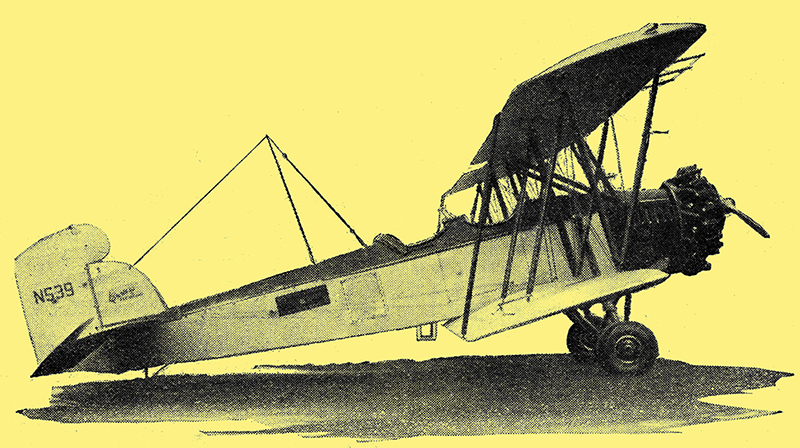
An American Bureau of Standards plane fitted with fog-landing radio gear as described in the article. For practice landings the pilot's cockpit is shrouded over with a canvas cover.
One of the great hazards in aircraft transportation is fog. Although a pilot can follow a radio beacon course from one point to another unerringly, and although he is in constant touch with the ground by radio, getting weather reports from a great number of stations, he is still 'up in the air' if he arrives at his destination in a fog.
Wireless, of such great aid to the ocean or air navigator, has now found a way to bring any properly equipped plane down to the ground in safety.Not long ago a radio engineer of the American Bureau of Standards left the Newark airport with his pilot for a week-end in Washington Monday came and they were due back in Newark. But the fog between the two cities kept all aircraft on the ground.
Fog-landing, however, was the business of this engineer and his pilot. They were accustomed to it. Many times they had taken off in fog or with a covering hood over their cockpit, and had come down again safely. So they took off at once, heading up into a soupy fog which almost immediately obscured the ground beneath them.
It was not difficult to follow the radio beacon during the three-hour flight from Washington to Newark, though, flying at 3,000 feet, they could see nothing but mist. By radio phone they communicated with Newark, requested that the fog equipment be turned on and that advice be given about wind conditions, etc. When they came within range of the new radio equipment they picked up the landing path beacon, got in the proper, orientation with respect to the runway and the prevailing wind, followed the curving path (the invisible radio beam) to the ground, and landed in perfect safety. Not until their wheels were nearly on the ground did their eyes perceive what their wireless equipment has told them.
It was an ideal demonstration of the fog-landing equipment which for several years has been in process of development at Washington under the immediate direction of H Diamond. For months he had tested the system on a small field near the Capitol, and despite bad landing conditions due to a small runway, rough terrain off the runway, tall chimneys near the field, and other obstacles, had shown to the satisfaction of many pilots that blind landing could be made safe.
The next step seemed to be to show what the system could do on a large airport. So they chose one of the busiest in the world, that at Newark, New Jersey, which serves New York City.
A Path of Waves
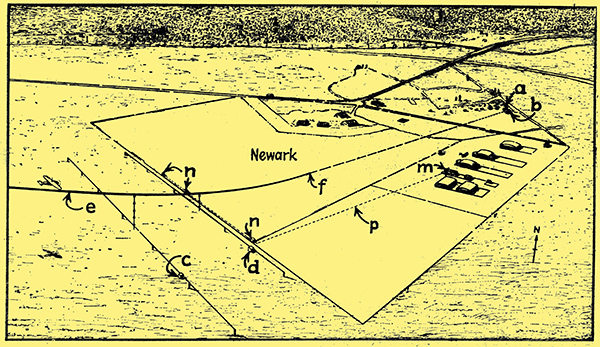
A perspective diagram of the radio layout. (a) and (b), the landing beam and runway beacon transmitters, (c) 2,000 ft. vertical marker, (d) boundary marker. (e) landing beam, (f) contact with ground, (m) headquarters and (p) communication lines.
The apparatus was moved from Washington and set up in Newark. Many new demonstrations were made. Pilots were taught to use the landing beam and to have faith in it. It now seems that similar installations will very soon be made .at all of the more important airports in the United States.
The system employs ultra-short waves by means of which a path curving upward from the ground at the proper angle can be set up for the pilot to follow to the ground. A radio beacon enables him to find the airport in good weather and bad, day or night, grain or shine; If he keeps on his course and this is not difficult he will receive signals until he is exactly over the beacon transmitter. At the instant of coincidence with the transmitter location the signals stop. Then, by a slight retuning of the beacon receiver, he can pick up another signal, also a directive beacon, which is parallel in the ether with the physical direction, of the runway on the ground. Once he has orientated his plane properly with respect to this new beacon he knows that the runway is either directly under him or at least that he is heading into it. Since the, receiver used for this purpose can be equipped with automatic volume control, in which case the grids of the HF amplifiers increase in bias and take less plate current as the signal be comes stronger, a plate current meter can be calibrated in miles from the air port instead of milliamperes.
Once on the runway beacon the pilot approaches the field. When he is 2,000 feet away he runs through a vertical wall of radio signals projected upward from a long, low horizontal antenna consisting of a single wire supported by posts. This vertical signal is modulated with a 1,250 Hz note. It is quite sharp, so that the pilot gets definite indication when he is directly over it. When he crosses the boundary of the field he runs through another vertical wall of signals, this one modulated with a 250 Hz note.
The pilot knows now that he is not only over the runway but over the field. Therefore he can land if he can see through the fog or he can rely on the next radio device, the landing beam. This is a highly directional horizontally-polarised beam of signals on a frequency of 90,800 kHz (3.3 metres). This beam leaves the ground at such an angle that the pilot can follow it down without trouble or danger. If the fog is thin enough to enable him to see the ground before he reaches it he will land in the conventional manner. It it is still so thick that he cannot see the ground he will throttle down his engine and pull back the stick for a three-point landing as soon as he crosses through the wall of signals indicating that he has crossed the boundary of the field.
Since the aircraft must land into the wind, the runway beacon which he must follow on his way to the ground must be aimed in the direction the prevailing wind blows during periods of bad visibility, or the landing runway beacon transmitter may be put underground in the centre of the field and rotated by remote control to locate the runway whenever the wind condition demands. At Newark, and probably at nearly all airports, the prevailing wind during such periods comes from one quarter, in this case from the north-east. The runway beacon transmitter is therefore located at the north-east corner of the field, by means of a goniometer the beam maybe directed to any location in this quadrant.
The transmitter consists of a 200 Watt, 278 kHz oscillator modulated with two signals, 65 and 86⅔ Hz, one signal going to each of two loop antennae which produce a figure eight space pattern. The intersection of these patterns produces four equi-signal zones. When the pilot gets out of these zones he gets a stronger signal from the nearer antenna, and from his receiving instrument can tell in which direction he is getting off the course.
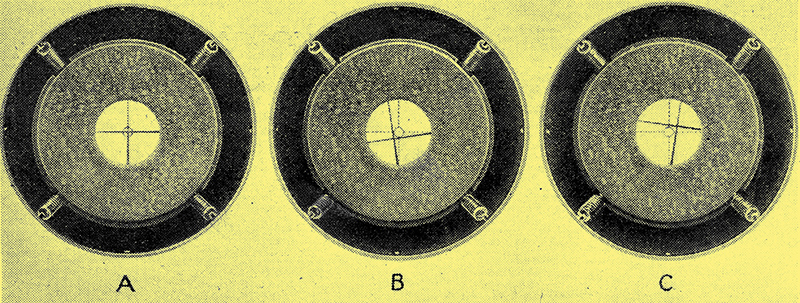
The pilot's indicating device showing the plane's position in respect of the runway and landing-beam. (A) On course, (B), below and to left of proper course, (C) Above proper course and to the right.
The beacon receiver employs two vibrating reeds tuned to the above-mentioned signals. These reeds are actuated by electromagnets the output of the receiver, and in turn, by their vibration, induce currents in pick-up coils. These currents are rectified and applied to the pointer of an instrument which tells the pilot at a glance where he is with respect to the runway.
The high-frequency transmitter uses two 500 Watt valves in push-pull connected to a directive array which sends the radiation upward at the desired angle. The receiver for this signal is very simple, containing no AVC circuit, so that the pilot must act as his own AVC system, and by so doing, i.e., by keeping the volume output constant, he can coast downward on the directive beam.
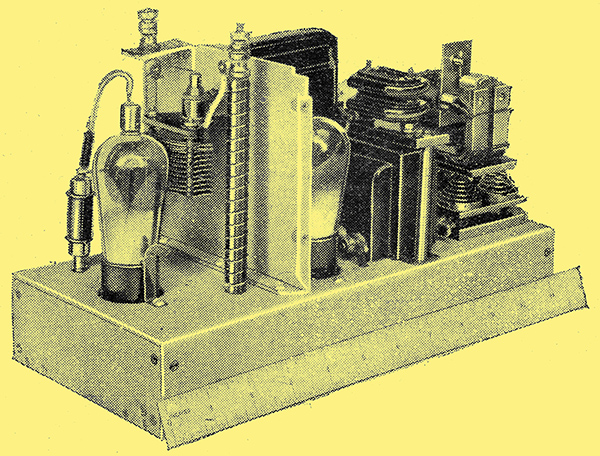
The ultra-short wave receiver as carried on the plane. Note the vibrator mechanism on the right.
The cost to equip an aircraft with the system is not great provided it already has the regulation radio equipment, which consists of a receiver for picking up the weather broadcasts and for two-way phone communication with the ground. An AVC system must be added to some of the beacon receivers; the ultra-short wave receiver is essential, This is very simple. In addition, an antenna for the landing beam must be provided. The chief cost is to the airport, where the runway beacon and the landing beam must be established. The cost, however, is small compared to the usefulness of the equipment and the safety from accident or delay due to fog or bad visibility.
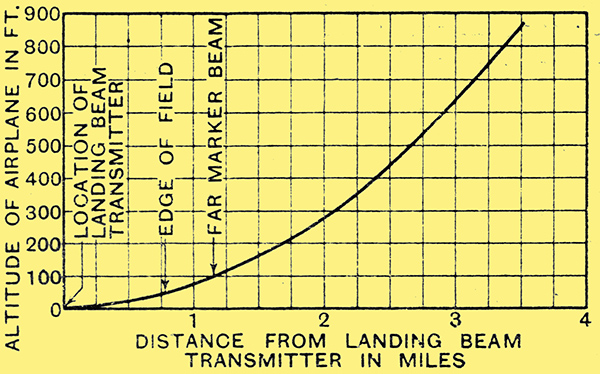
A graphic representation of the ultra-short-wave landing beam.
|